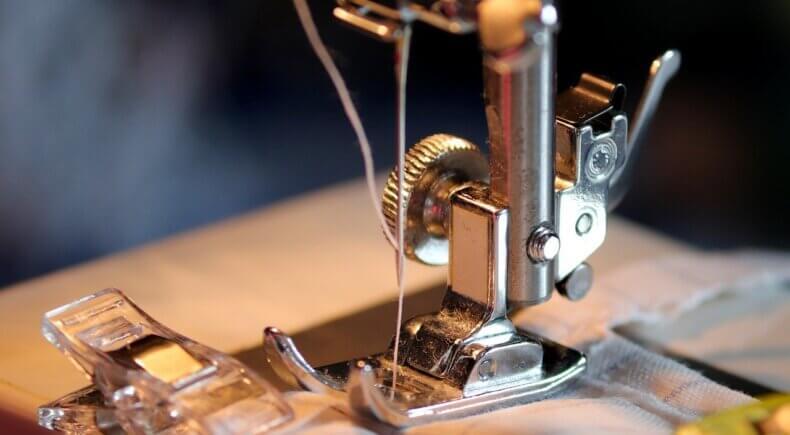
Knowing your Needles
The needle: Itís a small innocuous component of every embroidery machine that tends to get overlooked, even ignored ñ until it breaks. Even then, the typical response is to change it out and keep going. Small, inexpensive, rather boring, but extremely critical to the embroidery process. Without a needle, stitches could not be formed. Knowing your needles are critical. Needles have various.
Needle Application
While most shops are guilty of this or just don't know they use the same needle for all their designs and jobs. There are many types of needles available and we will cover some types of neeedles, applications for needles, types of needles and troubleshooting needles.
Needle Sizes and Applications
Below you will find a needle recommendation chart, which has the garment type, needle size and type of needle, While you can use the same needle for various applications sometimes the quality will be affected due to the wrong needle choices that you make or ignore.
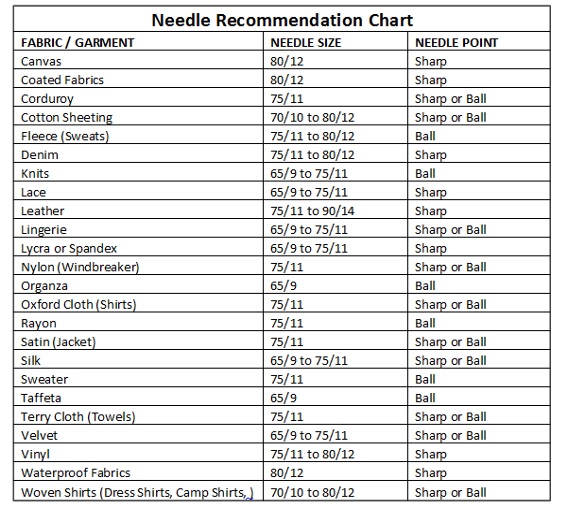
The System Number
The system number is an additional descriptive term for needles. It is actually a combination of numbers and/or letters referring to the total length of the needle and variations in the needle eye. Each machine is setup to use a specific needle system number. Changing to a needle with a different system number may require changing the timing of the machine.Here are some examples of commonly used needles for commercial embroidery machines. Your manufacturer will tell you which is appropriate for your model.
DBxK5 : This is considered the standard needle for many of the popular brands of commercial embroidery machines. It works well with most threads.
DBx7ST: This needle is similar to the DBxK5, except that it has a larger eye that is elongated and rectangular in shape. Itís designed to be used with metallic threads.
DBx9ST: This needle is designed for use with heavy embroidery threads and has an eye size twice as large as a basic needle such as the DBxK5. (In most cases, the above-listed needles are interchangeable.)
Needle Tips
The are a wide range of tips the most common is the sharp , but there are times when a wedge point or ball point can come in handy,
Needle Eye
The are times you will need to order a needle with a specifice eye size, especially for working with Metallic threads.
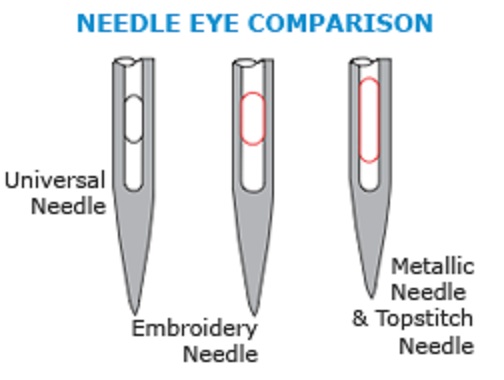
COATED NEEDLES
Needles may be available with a special non-stick coating that will reduce heat buildup and allow the needle eye to remain clear of thread or garment fibers. These needles are referred to as TeflonÆ-coated or Cool Sew, depending upon the manufacturer. Their ability to reduce friction makes them ideal for synthetics like cordura and nylon. The most common problems caused by needles are thread breaks, thread shreds and broken needles. In order to troubleshoot these problems you have to visualize the movements and path of the needle.
THREAD BREAKS
Needles only break when they encounter a solid obstruction. The only parts of a machine that the needle can run into are the hoop, the trimmer knife, the bobbin hook and the needle plate. Hitting the hoop is a pretty obvious problem that can be attributed to operator error. If a hoop crash does occur, either the design is larger than the hoop or the hoop was not centered properly before sewing.
The trimmer knife is sometimes the culprit behind a needle break. Though not a common occurrence, there are occasions where the trimmer knife (located below the needle plate) doesnít fully retract, placing it directly in the path of the descending needle. This is usually caused by a build-up of dirt in the retract area where the knife normally resides. You should periodically remove the needle plate and clean out any dust, dirt or lint buildup to prevent this from happening.If the bobbin hook timing gets out of synch, the needle may run into the bobbin hook as it descends. Machine timing is something that should not need frequent adjustment. However, in the case of a hoop crash, the timing might be affected, such that an adjustment becomes necessary. You can make a quick check by turning off the machine and manually rotating the main shaft while watching the needle go through a stitch cycle (remove the needle plate while doing this). It will be obvious if the needle is coming into contact with the hook. Most machines can be reset manually check with your machine manual.
NEEDLES BREAKING
By far, the most common source of needle-related problems is the needle coming in contact with the needle plate. As it sews, the point of the needle may be deflected slightly as it pierces the fabric being sewn. (Obviously a smaller needle such as the 65/9 will see more deflection than a larger one). If a mild deflection occurs, the needle will pass very close to the inside edge of the needle plate hole, possibly grazing it. This in turn may allow the upper thread (being carried by the needle) to rub along the edge of the needle plate hole as well, resulting in thread shreds or breaks.
If a more drastic needle deflection occurs, the needle itself may catch the edge of the needle plate hole, resulting in a broken needle. A prime example is a six-panel cap with a heavy center seam. As the needle encounters the edge of the seam, it may start deflecting slightly, which in turn leads to thread shreds, thread breaks and even needle breaks.
Thread shreds and thread breaks can also be caused by at least three other needle problems as follows:-
- Using a needle with an eye that is too small in relationship to the thickness of the thread.-
- A burr in the needle eye or along the front of the blade.-
- High temperature caused by friction during the sewing process.
If you start having sewing problems that can be attributed to the needle, donít hesitate to change it out, since the cost of a needle is only a few cents. Periodically replace your needles as they do get dull over time. Is there a recommended frequency for replacement? Ask your needle supplier. In reality, some fabrics will dull a needle faster than others, plus itís nearly impossible to track the usage of each needle on a multi-needle machine. So, itís difficult to determine needle life. When you see the quality of your stitching starting to decrease, then it might be time to change the needles.
Though small in size, needles can have a big impact on sewing. Donít take them for granted. Before starting each job, take a minute to analyze the needle requirements, then choose the correct needle for the job. This small sliver of silver can help you bring in the gold on every job.
Sometimes during the sewing process, you can end up with small cuts or holes around the edges of the embroidery (not to be confused with large holes left behind after a birdís nest develops). These small defects usually are less visible after the garment is unhooped, but they are still there, and can lead to quality problems in the long-term. In the case of a knit garment, small holes and/or cuts can lead to ìrunsî in the fabric after one or two washings. Here are the likely causes:
TROUBLESHOOTING NEEDLES
Replace the needle. Dull needles have difficult time getting through the garment, causing some fabrics to tear.
Wrong Needle Point Type , Sharp-point needles can cut some delicate knits. Try a ball-point needle.
Needle is too Large- Large needles can stretch fibers excessively, causing them to burst or become distorted. needle size that is still acceptable for the thread size you are using.
RULES FOR NEEDLES
- Rule #1 Sharp point needle for woven. Ball point needle for knits.
- Rule #2 Larger diameter needle for stiff, thick and/or heavyweight fabrics.
- Rule #3 Smaller diameter needle for lightweight and delicate fabrics.
- Rule #4 ñ Smaller diameter needle for intricate designs and/or small details.
- Rule #5 -- Small text under .30 inch use a 65/9 needle with 60weight thread
REVIEW
In taking a look at the different types of needles they also work hand in hand with your thread choices, not all jobs can be achieved by one type of needle will it work yes, will it look its best know.. In my shop I keep several types of needles a box of titanium coated 80/12 needles for carpets, 65/9 needles with 60 wt thread for doing small letters, and a box of ball point needles when sharp needles won't work. A box of Wedge point needle for leather work. While a sharp needles are used primarly in the industrial shops its a good ideam to use special needles for some applications so you get better results.


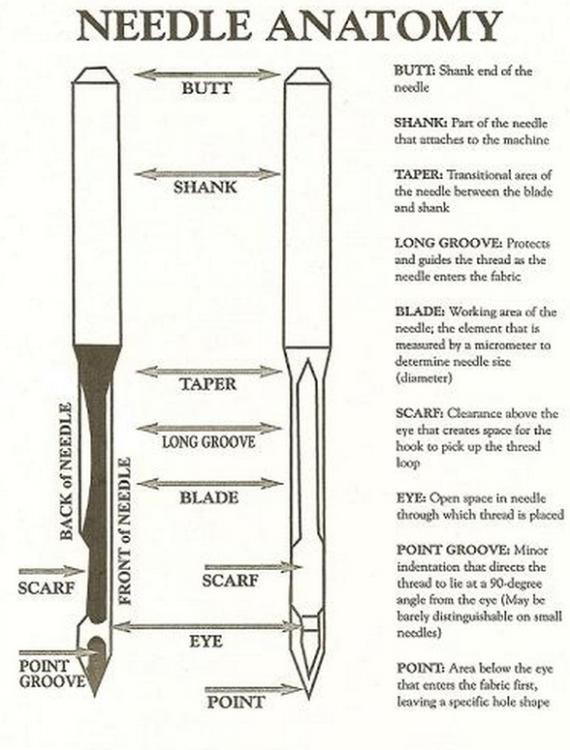
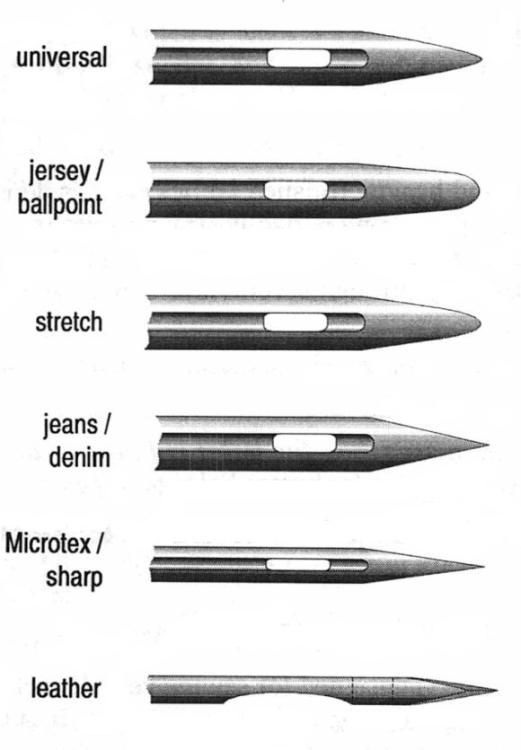


Recommended Comments